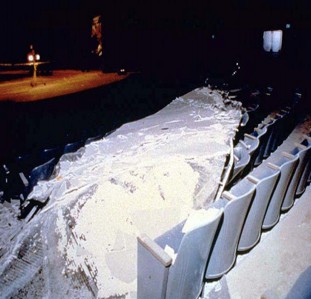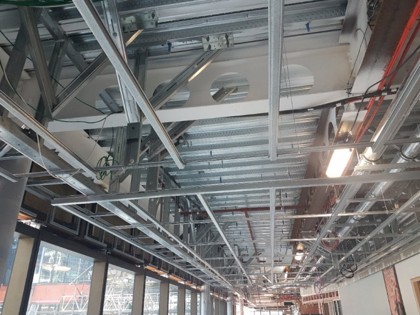Performance of Non-Structural Elements during previous Earthquakes
The importance of good earthquake performance of nonstructural components, equipment, and systems required for post-earthquake recovery and facility function/ operation is often overshadowed by the focus on building structural damage. A review of the typical damage sustained in recent earthquakes highlights the fact that the poor performance of nonstructural components, equipment, and systems is the greatest contributor to damage, losses, and business interruption for most facilities.
Measures taken to protect the safety of NSE’s during an earthquake are taken only once it is ensured that the Structural Elements (SE’s) have been been secured sufficiently and are safe under the expected level of earthquake ground shaking.
NSE’s that are heavy and big in size have a tendency to slide or topple over if they are not seismically restrained/anchored properly. For example, a chilled water pump not seismically anchored to the ground using a Seismic Snubber can topple over during an earthquake and its functionality takes a big hit.
Historical Performance of Nonstructural Components
Past earthquakes can teach us valuable lessons regarding the vulnerabilities of nonstructural systems to even moderate levels of ground motion. For example, the 1994 Northridge Earthquake caused significant nonstructural damage to a number of area hospitals. In these instances, the hospitals remained structurally sound, but required closure due to significant damage to nonstructural components—primarily water damage and loss of emergency utility function. The problem lies in the treatment of these commodities in the building design codes.
The damage caused by not securing NSE’s can be seen through the pictures below.


The picture on the left shows damage to hanging light fixtures that were not seismically secured. The picture on the right shows the collapse of a false ceiling.
The damage shown in the pictures can be avoided through careful designing and installing seismic bracing to secure the light fixtures as well as the false ceilings. The picture below is an example of a brace-like anchor that will ensure that the NSE’s such as ducts and pipes does not collapse in the event of an earthquake.

Practical Concerns related to securing NSE’s
The percentage cost of NSE’s to the whole project has risen immensely in India in the last few years. NSE’s account for 70% of the cost of a building construction nowadays as compared to a lowly 5% four decades ago. The manufacturers of NSE’s need to study in details the response of their equipments used in different projects to earthquake. Following this, they should combine with consultants and contractors and design appropriate seismic safety measures to secure these NSE’s, which should be thoroughly tested on shake tables. All these measures add to the overall cost of the building construction, but are necessary to ensure there is no loss of life and building functionality.
